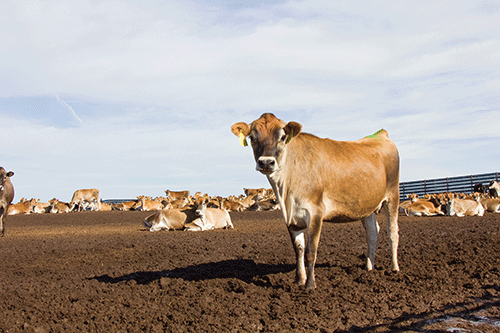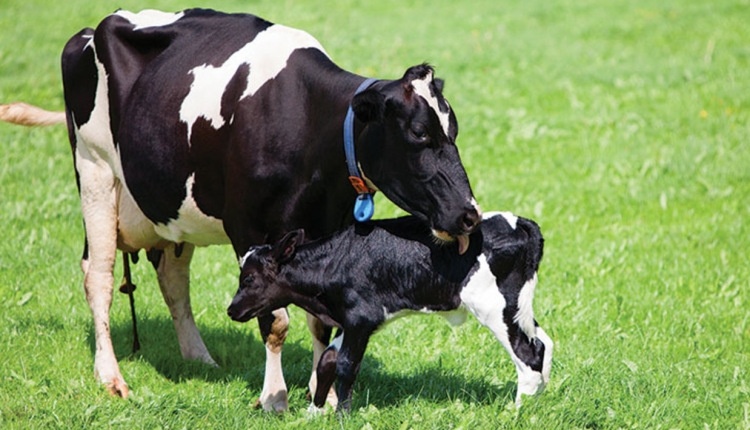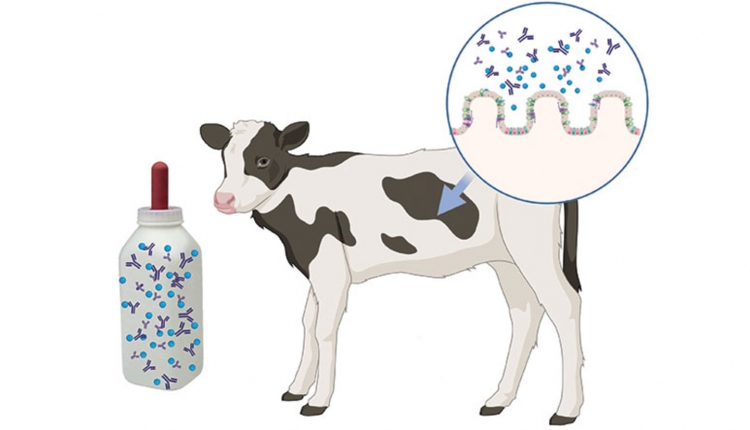The author is a veterinary consultant in Wayland, Mich.

Not only will shortcuts reduce a heifer's potential, they will reduce your returns.
There is a problem in our industry today. Too many animals are underperforming in their first lactation, and it is costing producers real money.
The reality is that statistically we get less than three lactations from a dairy cow before she leaves the herd. I know there are old healthy cows in many herds, and people think this statistic must be about someone else's farm. But, the facts are in, and this is something we need to understand. We cannot allow our first-lactation heifers to fall short of their potential. The reasons why this happens so often are many, but the high cost of heifer raising is at the root of the problem.
Not so many years ago most producers raised their own replacements, and the cost of doing so was less than or equal to current springing heifer market prices. Feed costs were contained by feeding refusals from the lactating herd and utilizing some of the lower quality forages available on farm.
Further, most producers understood they were feeding their future herd and accepted the growing period as a cost of production. They looked forward to the superior genetics that would enter their herd in the future and took pride in their heifer program.
Now fast forward to 2013. We are experiencing crushing spikes in all feed costs. Expanding dairies can no longer keep young stock on the same farm as the milking herd due to stricter environmental regulations and an insufficient land base. Banks are willing to make loans for lactating facilities but are not as excited about heifer and dry cow facilities that don't generate immediate income.
Enter the era of custom heifer raising, and we have added yet another dimension to the cost equation . . . profit! The need for profit in custom heifer raising, plus runaway feed costs, is proving to be a bad combination for many producers. This is further compounded by an oversaturated market, where some producers are selling surplus heifers (think sexed semen) for cash flow and added income. As a result, heifers often sell at a price less than it costs to raise them.
A rock and a hard place
For many consultants, the interaction between producers and their heifer raisers is one fraught with difficulties. To put it bluntly, the growers want more money, and the producers don't want to pay it. If a fair agreement is not reached, the heifers are always the losers.
Producers often seem unwilling to pay more than just the bare bones cost of raising a heifer. The custom grower knows that a return on labor and investment is necessary to run a business and will balance the books one way or another.
To help bridge this gap, I sometimes have to bring my clients back to reality on heifer raising costs by making rations with on-farm feed costs. It's a real eye-opener to see some large heifer diets with prices approaching $2 per day! It makes us realize how much this market has escalated. Producers must realize the true cost of heifer raising before negotiating a price for custom raising.
Some of the blame for undersized or thin heifers involves decisions made by the custom raisers. In a feed market that has escalating prices, it is easy to hold one's hand out and demand more money, feed lower quality rations or crowd more heifers into the system to better margins. It is also easy to pass on market costs rather than true production costs of forages, and many feel this is fair. It is much more difficult to do like so many dairy producers do on a daily basis and find more ways to improve efficiencies in their business.
There are creative ways to feed heifers, and growers need to "think outside the box" and work with innovative nutritionists who can utilize undervalued feeds and fiber sources and make cost-effective rations that work. Only by meeting each other halfway can we produce a heifer that is capable of stepping up and realizing her full first-lactation potential.
What we should expect
Size matters. Most of us know that a Holstein heifer should be about 1,350 pounds, 55 inches tall at the withers and have a body condition score of 3.0 to 3.25 at calving. This height and weight ensures that a heifer will not spend the first half of her lactation trying to catch up. Heifers that have growing to do will simply not milk as much as their full-grown counterparts, and recent research suggests that we will lose permanent lifetime milk due to problems that interrupt or delay growth (especially in the early months of life).
To further ensure a heifer's success, we would like her to not compete with older cows. One of the dairies I work with recently separated heifers in the first half of their lactation from cows and raised peak milk by 3 pounds per heifer. This translates into more total milk, at least 750 pounds, potentially due to first-calf heifers' abilities to maintain lactation persistence.
We can expect that a heifer fully grown at calving will attain a peak milk of 70 percent of her older herdmates . . . even 75 percent in some herds. Many dairies perform under this benchmark, and there is real money left on the table.
Do a little math. A 5-pound improvement in heifer peak production is worth about $250 per lactation. If just half of that was applied to her diet during her life, it would allow 20 cents more feed per day, and properly balanced that might be the difference between a heifer that calves at 1,200 and is 53 inches tall versus a fully grown heifer that has a stellar first lactation.
This is not a call for bigger heifers, rather it expresses a need to attain an ideal percent of her adult size whether she is genetically large or small. This concept holds across all breeds.
If we get three or less lactations from a cow, can we afford to let any of her first-lactation potential slip through our fingers? Let's re-evaluate our home-raised heifers or sit down and discuss heifer expectations and costs with our custom raisers. Then let's do the measuring and weighing to assure we are accomplishing what we set as our goals because our heifers do need to "hit the ground running."
Click here to return to the Calf & Heifer E-Sources
1306_402

There is a problem in our industry today. Too many animals are underperforming in their first lactation, and it is costing producers real money.
The reality is that statistically we get less than three lactations from a dairy cow before she leaves the herd. I know there are old healthy cows in many herds, and people think this statistic must be about someone else's farm. But, the facts are in, and this is something we need to understand. We cannot allow our first-lactation heifers to fall short of their potential. The reasons why this happens so often are many, but the high cost of heifer raising is at the root of the problem.
Not so many years ago most producers raised their own replacements, and the cost of doing so was less than or equal to current springing heifer market prices. Feed costs were contained by feeding refusals from the lactating herd and utilizing some of the lower quality forages available on farm.
Further, most producers understood they were feeding their future herd and accepted the growing period as a cost of production. They looked forward to the superior genetics that would enter their herd in the future and took pride in their heifer program.
Now fast forward to 2013. We are experiencing crushing spikes in all feed costs. Expanding dairies can no longer keep young stock on the same farm as the milking herd due to stricter environmental regulations and an insufficient land base. Banks are willing to make loans for lactating facilities but are not as excited about heifer and dry cow facilities that don't generate immediate income.
Enter the era of custom heifer raising, and we have added yet another dimension to the cost equation . . . profit! The need for profit in custom heifer raising, plus runaway feed costs, is proving to be a bad combination for many producers. This is further compounded by an oversaturated market, where some producers are selling surplus heifers (think sexed semen) for cash flow and added income. As a result, heifers often sell at a price less than it costs to raise them.
A rock and a hard place
For many consultants, the interaction between producers and their heifer raisers is one fraught with difficulties. To put it bluntly, the growers want more money, and the producers don't want to pay it. If a fair agreement is not reached, the heifers are always the losers.
Producers often seem unwilling to pay more than just the bare bones cost of raising a heifer. The custom grower knows that a return on labor and investment is necessary to run a business and will balance the books one way or another.
To help bridge this gap, I sometimes have to bring my clients back to reality on heifer raising costs by making rations with on-farm feed costs. It's a real eye-opener to see some large heifer diets with prices approaching $2 per day! It makes us realize how much this market has escalated. Producers must realize the true cost of heifer raising before negotiating a price for custom raising.
Some of the blame for undersized or thin heifers involves decisions made by the custom raisers. In a feed market that has escalating prices, it is easy to hold one's hand out and demand more money, feed lower quality rations or crowd more heifers into the system to better margins. It is also easy to pass on market costs rather than true production costs of forages, and many feel this is fair. It is much more difficult to do like so many dairy producers do on a daily basis and find more ways to improve efficiencies in their business.
There are creative ways to feed heifers, and growers need to "think outside the box" and work with innovative nutritionists who can utilize undervalued feeds and fiber sources and make cost-effective rations that work. Only by meeting each other halfway can we produce a heifer that is capable of stepping up and realizing her full first-lactation potential.
What we should expect
Size matters. Most of us know that a Holstein heifer should be about 1,350 pounds, 55 inches tall at the withers and have a body condition score of 3.0 to 3.25 at calving. This height and weight ensures that a heifer will not spend the first half of her lactation trying to catch up. Heifers that have growing to do will simply not milk as much as their full-grown counterparts, and recent research suggests that we will lose permanent lifetime milk due to problems that interrupt or delay growth (especially in the early months of life).
To further ensure a heifer's success, we would like her to not compete with older cows. One of the dairies I work with recently separated heifers in the first half of their lactation from cows and raised peak milk by 3 pounds per heifer. This translates into more total milk, at least 750 pounds, potentially due to first-calf heifers' abilities to maintain lactation persistence.
We can expect that a heifer fully grown at calving will attain a peak milk of 70 percent of her older herdmates . . . even 75 percent in some herds. Many dairies perform under this benchmark, and there is real money left on the table.
Do a little math. A 5-pound improvement in heifer peak production is worth about $250 per lactation. If just half of that was applied to her diet during her life, it would allow 20 cents more feed per day, and properly balanced that might be the difference between a heifer that calves at 1,200 and is 53 inches tall versus a fully grown heifer that has a stellar first lactation.
This is not a call for bigger heifers, rather it expresses a need to attain an ideal percent of her adult size whether she is genetically large or small. This concept holds across all breeds.
If we get three or less lactations from a cow, can we afford to let any of her first-lactation potential slip through our fingers? Let's re-evaluate our home-raised heifers or sit down and discuss heifer expectations and costs with our custom raisers. Then let's do the measuring and weighing to assure we are accomplishing what we set as our goals because our heifers do need to "hit the ground running."
1306_402








